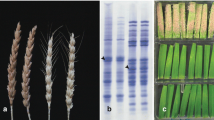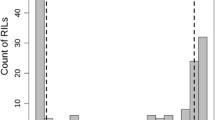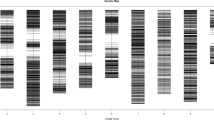Abstract
One hundred and ten markers were analysed for linkage in 218 F2 plants derived from two divergent cultivars (‘Védrantais’ and ‘Songwhan Charmi’) of Cucumis melo (L.). Thirty-four RFLPs, 64 RAPDs, one isozyme, four disease resistance markers and one morphological marker were used to construct a genetic map spanning 14 linkage groups covering 1390 cM of the melon genome. RAPD and RFLP markers detected similar polymorphism levels. RFLPs were largely due to base substitutions rather than insertion/deletions. Twelve percent of markers showed distorted segregation. Phenotypic markers consisted of two resistance genes against Fusarium wilt (Fom-1 and Fom-2), one gene (nsv) controlling the resistance to melon necrotic spot virus, one gene (Vat) conferring resistance to Aphis gossypii, and a recessive gene for carpel numbers (3 vs 5 carpels: p).
Similar content being viewed by others
References
Adam-Blondon AF, Sevignac M, Dron M (1994) A genetic map of common bean to localize specific resistance genes against anthracnose. Genome 37:915–924
Allard RW (1956) Formulas and tables to facilitate the calculation of recombination values in heredity. Hilgardia 24:235–278
Arumanagathan K, Earle ED (1991) Nuclear DNA content of some important plant species. Plant Mol Biol Rep 9:208–218
Balagué C, Watson CF, Turner AJ, Rouge P, Picton S, Pech JC, Grierson D (1993) Isolation of a ripening and wound-induced cDNA from Cucumber melo L. encoding a protein with homology to the ethylene-forming enzyme. Eur J Bioche, 212:27–34
Baudracco-Arnas S (1995) A simple and inexpensive method for DNA extraction from Cucumis melo L. Cucurbit Genet Coop Rep 18:50–51
Coudriet DL, Kishaba AN, Bohn GW (1981) Inheritance of resistance to muskmelon necrotic spot virus in a melon aphid-resistant breeding line of muskmelon. J Am Soc Hort Sci 106:789–791
Dane F (1983) Cucurbits. In: Tanksley SD, Orton TJ (eds) Isozymes in plant genetics and breeding, part B. pp 369–390
Ellis THN, Turner L, Hellens RP, Lee D, Harker CL, Enard C, Domoney C, Davies DR (1992) Linkage maps in pea. Genetics 130:649–663
Esquinas JT (1981) Allozyme variation and relationships among Spanish land-races of Cucumis melo L. Kulturpflanze 29: 337–352
Giese H, Holm-Jensen AG, Mathiassen H, Kjœr B, Rasmussen SK, Bay H, Jensen J (1994) Distribution of RAPD markers on a linkage map of barley. Hereditas 120:267–273
Heun M, Helentjaris T (1993) Inheritance of RAPDs in F1 hybrids of corn. Theor Appl Genet 85:961–968
Kennard WC, Poetter K, Dijkhuizen A, Meglic V, Staub JE, Havey MJ (1994) Linkage among RFLP, RAPD, isozyme, disease-resistance, and morphological markers in narrow and wide crosses of cucumber. Theor Appl Genet 89:42–48
Kosambi DD (1944) The estimation of map distances from recombination values. Ann Eugen 12:172–175
Lander ES, Botstein ED (1989) Mapping Mendelian factors underlying quantitative traits using RFLP linkage maps. Genetics 121:185–199
Landry BS, Kesseli RV, Farrara B, Michelmore RW (1987) A genetic map of lettuce (Lactuca sativa L.) with restriction fragment length polymorphism, isozyme, disease resistance and morphological markers. Genetics 116:331–337
Lark KG, Weisemann JM, Matthews BF, Palmer R, Chase K, Macalma T (1993) A genetic map of soyben (Glycine max L.) using an intraspecific cross of two cultivars: ‘Minosy’ and ‘Noir1’ Theor Appl Genet 86:901–906
Lefebvre V, Palloix A, Rives M (1993) Nuclear RFLP between pepper cultivars (Capsicum annum L.) Euphytica 71:189–199
Marrou J (1967) Amélioration des méthodes de transmission mécanique des virus par adsorption des inhibiteurs d'infection sur le charbon végétal. CR Acad Agric France 53:972–981
McCouch SR, Kochert G, Yu ZH, Wang ZY, Khush GS, Coffman WR, Tanksley SD (1988) Molecular mapping of rice chromosomes. Theor Appl Genet 76:815–829
Neuhausen SL (1992) Evaluation of restriction fragment length polymorphism in Cucumis melo. Theor Appl Genet 83:379–384
Paran I, Michelmore RW (1993) Development of reliable PCR-based markers linked to downy mildew resistance genes in lettuce. Theor Appl Genet 85:985–993
Perl-Treves R, Zamir D, Navot N, Galun E (1985) Phytogeny of Cucumis based on isozyme variability and its comparison with plastome phylogeny. Theor Appl Genet 71: 430–436
Pitrat M (1991) Linkage groups in Cucumis melo L. J Hered 82:406–411
Pitrat M (1994) Gene list for Cucumis melo L. Cucurbit Genet Coop Rep 17:135–148
Pitrat M, Lecoq H (1980) Inheritance of resistance to cucumber mosaic virus transmission by Aphis gossypii in Cucumis melo. Phytopathology 70:958–961
Quiot JB, Douine L, Gebre Selassie K (1979) Fréquence des principales viroses identifiées dans une exploitation maraîchère du Sud-Est de la France. Ann Phytopathol 11:283–290
Ramachandran C, Seshadri VS (1986) Cytological analysis of the genome of cucumber (Cucumis sativus L) and muskmelon (Cucumis melo L.). Z Pflanzenzuchtg 96:25–38
Risser G (1973) Etude de I'hérédité de la resistance du melon (Cucumis melo) aux races 1 et 2 de Fusarium oxysporum f. sp. melonis. Ann Amélior Plant 23:259–263
Risser G, Mas P (1965) Mise en évidence de plusieurs races de Fusarium oxysporum f. sp. melonis. Ann Amélior Plant 15:405–408
Rosa JT (1928) The inheritance of flower types in Cucumis and Citrullus. Hilgardia 3:233–250
Shattuck-Eidens DM, Bell RN, Neuhausen SL, Helentjaris T (1990) DNA sequence variation within maize and melon: observations from polymerase chain reaction amplification and direct sequencing. Genetics 126:207–217
Staub JE, Fredrick L, Marty TL (1987) Electrophoretic variation in cross-compatible wild diploid species of Cucumis. Can J Bot 65:792–798
Wendel JF, Weeden NF (1990) Visualization and interpretation of plant isozymes. In: Soltis, DE, Soltis PS (eds) Isozymes in plant biology. Dioscorides Press, Portland. Oregon, pp 5–45
Williams JGK, Kubelik AR, Livak KJ, Rafalsky JA, Tingey SV (1990) DNA polymorphism amplified by arbitrary primers are useful as genetic markers. Nucleic Acids Res 18:6531–6535
Author information
Authors and Affiliations
Additional information
Communicated by G. Hart
Rights and permissions
About this article
Cite this article
Baudracco-Arnas, S., Pitrat, M. A genetic map of melon (Cucumis melo L.) with RFLP, RAPD, isozyme, disease resistance and morphological markers. Theoret. Appl. Genetics 93, 57–64 (1996). https://doi.org/10.1007/BF00225727
Received:
Accepted:
Issue Date:
DOI: https://doi.org/10.1007/BF00225727




